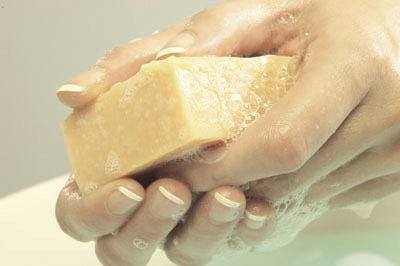Next time you lather up in the shower with your favorite pomegranate-grapefruit body wash, think about what exactly you are washing down the drain. You may be disturbed to find out your standard volumizer shampoo and detangler conditioner are toxic, even brands claiming to be natural and earth friendly.
That is the puzzle Shelly Skofield is setting out to solve: Which body products are safe for the environment?
“Awareness is the biggest part of this project, getting people to think about how much product do they use and is it necessary?” Skofield said. “I want to find out which products are the most harmful to be more informed about choices.”
Skolfield, a Reed College student and summer intern in toxicology at the Lopez-based nonprofit laboratory Kwiaht, will test more than 50 popular body care products sold in the islands and publish her findings.
According to the federal Food and Drug Administration website, cosmetics including moisturizers, perfumes, shampoos, toothpastes and deodorant must be tested for safety for consumers, but Kwiaht Director Russel Barsh says manufacturers are not required to test the impacts of releasing these products into the environment.
According to Alan Bennett, FDA public affairs specialist, there are “no general rules, but if there is an environmental issue it could be included in a regulation.”
There are plenty of tests to protect humans like ecological toxicity eye irritation tests, said Skofield, but human skin is a lot different than gills or the shell of a crustacean.
“Many [soaps] contain emulsifiers, fragrances and colorants that can be harmful to fish,” Barsh said. “Few have been independently tested.”
There are many types of emulsifiers, everything from eggs to sodium borate and wax to chemicals. The problem with soap, according to Barsh, is that certain ingredients can damage cell membranes and interfere with animals’ signaling systems.
“Soaps also ‘mobilize’ (emulsify) toxins such as pesticides and PCBs in water, pulling them out of the sediment (where they adsorb to clay particles) and putting them back into suspension in the water where they can do more harm,” Barsh said.
Washing soap down the drain is not his biggest concern, although large quantities of soap can kill the bacteria in a septic system, causing it to stop working and allowing soaps to pass through the system unchanged.
Because a majority of islanders live a short distance from wetlands and shorelines, the Kwiaht study aims to help consumers as they search the store shelves for environmentally friendly soaps and cosmetics.
“They have little to guide them except manufacturers’ claims,” Barsh said. “State and federal law do not require that all of the ingredients in personal care products be tested or disclosed.”
Even plant extracts such as chamomile and cloves, which have the appeal of being “healthy, or at least harmless” can be dangerous. According to Barsh, “essential oils” and “natural” fragrances are often defenses that plants evolved to kill chewing and sucking insects. They also can kill the tiny aquatic animals that fish rely on for food. Lead, cyanide and strychnine are all “natural,” but also toxic.
“Plants have been battling animals for millions years and have some potent chemicals,” Skolfield said.
Barsh is also concerned that labels are misleading – advertising “no sodium lauryl sulfate,” but listing “sodium laureth sulfate” among their ingredients.
These two compounds are closely related chemically and have the same negative effects on aquatic organisms, according to Barsh.
“Surfactants [chemicals that break down dirt and make it easier to wash away] derived from coconut oil sound safe, but can include sodium lauryl sulfate and sodium laureth sulfate,” said Barsh, who has come to the conclusion that many products are unsafe after exposing daphnia, a tiny freshwater crustacean, to small concentrations of products over time, causing them to die or become immobile.
Daphnia can be found in the islands’ healthier wetlands and ponds in the spring, where they are eaten by frogs, newts, and aquatic insects such as dragonfly larvae.
Surfactants have also been found as problematic for humans. Some chemicals like 1,4-dioxane, which causes carcinomas in mice and mesotheliomas in rats according to the World Health Organization’s International Agency for Research on Cancer, are a byproduct of the manufacturing process used to create other ingredients of primary importance, like surfactants.
The solution?
Barsh suggests that consumers avoid soaps with a lot of fragrances and essential oils. Skofield uses fragrance-free shampoo and only washes her hair once a week. She said people don’t have to stop using soap, but can modify their hygiene routine. If you really want to be non-toxic, experiment with using a few teaspoons of finely powdered clay in the bath or shower, which absorbs grease and oil.
“The biggest problem is that soaps need not be tested for their aquatic toxicity or persistence,” Barsh said. “That leaves regulators and consumers high and dry.”
For more info, email kwiaht@gmail.com.



